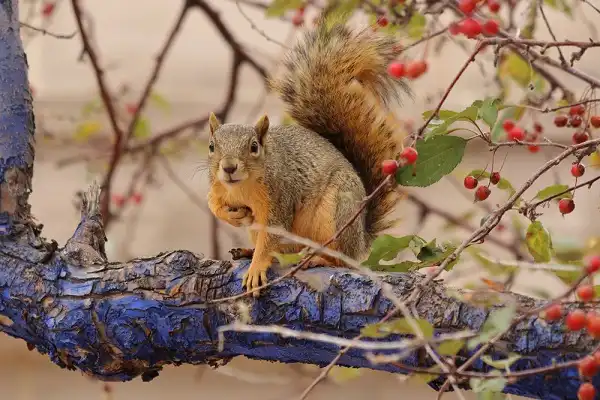The fox squirrel is the largest tree squirrel in North America. They are easily recognized by their reddish brown fur and long, fluffy tails. Although they are commonly found in wooded areas, they are also known to inhabit urban areas. These adaptable creatures can be a nuisance to homeowners who find them raiding bird feeders and digging through trash cans. But despite their often pesky behavior, fox squirrels are fascinating animals that play an important role in the ecosystem.

Fox Squirrel Description
Fox squirrels are usually reddish-brown in color with a white belly. They have large, bushy tails that can be almost as long as their bodies. Fox squirrels have grizzled gray-brown fur with buff-colored patches on their sides and light tan to white fur on their bellies. They have large eyes and flatter faces than other species of tree squirrels, which helps them detect predators more easily. Their large size helps them survive the cold winters of North America by allowing them to store fat during the summer months.
Fox Squirrel Habitat
Fox squirrels are most commonly found in hardwood forests and wooded areas, particularly those with nut-bearing trees such as oak, hickory, and walnut. They can also be found in some urban parks and backyards where food sources are abundant. When it gets cold outside, fox squirrels will often seek out shelter in hollow trees or abandoned bird nests. While they may sometimes enter homes, they typically only do so to find a warm place to stay or to see if food is available. Fox squirrels are most active during the day but may venture out at night if temperatures are warm enough. During the summer months, they spend their days gathering nuts to store for the winter months when food is scarce. Fox squirrels prefer to live alone unless they happen to be raising young. In these cases, the mother looks after her kits until they are old enough to fend for themselves. Fox Squirrels play an important role in their local ecosystems by aiding in seed dispersal and promoting overall plant diversity through their creative foraging habits. Their burrowing behavior can also help aerate the soil which encourages healthy plant growth over time.
Fox Squirrel Diet
Fox squirrels have a varied diet which includes a wide variety of items. Their mainstay is composed of nuts, fruits, seeds, and buds from trees and shrubs. They can also occasionally eat insects, bird eggs, and fungi. Fox squirrels have been observed to store large amounts of food in caches throughout their range so they can access it when food sources become scarce during the winter months. In addition to these natural foods, fox squirrels are also known to take advantage of human-provided sources such as bird feeders and gardens with ripe vegetables and herbs. They may also raid garbage cans or compost piles for leftovers and other scraps that can provide sustenance. Furthermore, fox squirrels have been known to consume fallen fruit from neighborhood trees if they are unable to find enough nuts or seeds to sustain themselves. Fox Squirrels are also very resourceful creatures that often use their environment to help them access hard-to-reach food sources. For example, they have been known to use debris piles as ramps so they can climb up stumps or logs in order to reach fruit-bearing branches that would otherwise be out of reach. This creative behavior allows them to explore new areas in search of more sustenance without having to expend too much energy doing so.

Fox Squirrel Size
Fox Squirrels are a type of tree squirrel that is native to North America. They typically range in size from 12-18 inches in length, including the tail, and weigh between 1-2 lbs. The bushy tail of the fox squirrel is usually long and can stretch up to 10 inches in length. This tail acts as a counterbalance when climbing trees or jumping from branch to branch. Additionally, it helps provide insulation against cold temperatures when they curl up into a ball while sleeping at night. Fox squirrels are adept climbers and routinely use tree branches as pathways to access food sources or escape danger. They have strong hind legs which help them jump impressive distances between trees or onto the ground below without suffering any serious injury. Furthermore, fox squirrels will dig burrows for temporary shelters near food sources or areas of dense vegetation for protection from predators.
Fox Squirrel Lifespan
Fox squirrels are generally considered to be medium-sized animals and can live up to 10 years in the wild if they are well-protected from predators and given access to a steady source of food. In captivity, fox squirrels have been known to live for up to 16 years due to the controlled environment and increased availability of food sources. Fox squirrels reach sexual maturity when they are between 1 and 2 years old, depending on the region. Females usually give birth twice a year, with litters ranging in size from 1-7 young. The gestation period lasts around 42 days, after which time the mother will carefully nurture her newborns until they are old enough to leave their den and start exploring their environment. The longevity of fox squirrels is largely dependent on their ability to locate sufficient amounts of food throughout each season. With adequate nutrition, these small mammals can remain healthy and active for many years. During winter months, when food sources become scarce, fox squirrels often rely on stored caches of nuts or seeds to survive until warmer weather returns.

Fox Squirrel Behavior
Fox squirrels are highly adaptable animals that exhibit a variety of behaviors depending on their environment. They are diurnal creatures and most active during the day when they can take advantage of more favorable conditions for locating food, building nests, and socializing with other members of their species. Fox squirrels primarily communicate with each other through body language and vocalizations. Their postures, expressions, and tail gestures can indicate both aggression towards intruders or other squirrels as well as the general state of comfort or anxiety. Vocally, fox squirrels make a wide range of noises such as barks, growls, squeaks, and chirps to either assert dominance over their territory or express excitement upon spotting food sources. When it comes to finding food sources in the wild, fox squirrels have several strategies that they employ.
They will search high up in trees for nuts and fruits that have been left behind by birds or other animals as well as look for mushrooms and grubs among leaf litter on the forest floor. Additionally, they are known to raid bird feeders or dig up caches of stored nuts from previous seasons when necessary. Fox squirrels also spend considerable amounts of time constructing homes or dens for shelter and protection from the elements. Typically these dwellings will be built in hollowed-out tree trunks and lined with grasses or mosses for insulation against cold temperatures during winter months. As a communal species, fox squirrels often form small colonies where parents raise their young together in order to build stronger family ties and provide mutual support against potential predators.
Fox Squirrel Speed
Fox squirrels are known for their impressive agility and speed when navigating through treetops. They have been recorded running up to 20 miles per hour when chasing after food sources or running from predators. Additionally, they are capable of making precise jumps and sharp turns while navigating complex networks of branches with ease. When racing across the forest floor, fox squirrels can reach speeds of 8-10 mph, making them some of the quickest animals in the rodent family. However, their escape tactics do not end there. They also possess an incredible ability to maneuver swiftly between trees by using their tail as a stabilizing rudder while leaping from branch to branch at lightning-quick speeds. Perhaps one of the most remarkable feats of this species’ athleticism is demonstrated by its vertical climbing skills. Fox squirrels have been witnessed scurrying up tree trunks at a rate of 10 feet per second and can even scale straight up a 90-degree angle wall with no difficulty! This amazing agility makes them one of the few mammals that are able to climb so quickly and efficiently in both directions – vertical and horizontal.

Fox Squirrel Hunting
Fox squirrel hunting is a popular pastime for many outdoorsmen, as these animals are both enjoyable to hunt and easy to find. Known for their agility and speed when navigating through treetops, fox squirrels have been known to travel at speeds of up to 20 miles per hour while searching for food sources or running from predators. While they may be swift in the air, these creatures must make their way down to the ground before they can be hunted. Fox squirrels are most commonly active during the day and spend their time gathering food and chasing games with other members of their kind. Because of this activity, hunters usually have an easier time locating them as they traverse through trees or scamper across open fields. In order to effectively hunt fox squirrels, it is important for a hunter to remain still and quiet so as not to alert any nearby prey. A successful fox squirrel hunt requires patience and skill in order for a hunter to find success. This may include setting traps around bait that attract hungry animals or setting up blinds near areas where they travel frequently in order to ambush them when they move close enough. Additionally, certain scents like sweet corn may draw in curious animals that are looking for a snack while allowing hunters the chance to line up a good shot without alarming them too soon.
Conclusion
Fox squirrels are truly amazing animals that possess a variety of remarkable abilities. From their impressive speed and agility, while maneuvering through treetops to their exceptional senses which allow them to easily spot predators or search for food, these creatures never fail to amaze us with their behavior. Fox squirrel hunting is also another activity that outdoorsmen can experience due to the animal’s tendency to seek out food sources in open fields or trees. No matter what one chooses to do when interacting with fox squirrels, it is important for all of us to understand the importance of conserving these animals and protecting their habitats so that future generations can continue witnessing their captivating abilities and behaviors!
Frequently Asked Question

